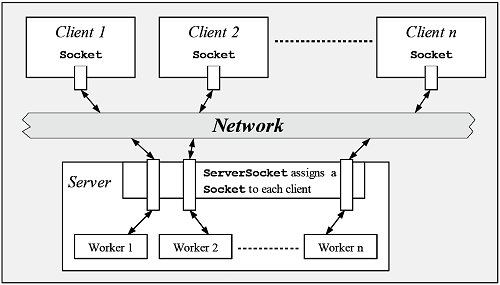
| Home : Course Map : Chapter 13 : |
|
Client/Server
|
| JavaTech |
| Course Map |
| Chapter 13 |
|
Network
Overview |
| About
JavaTech Codes List Exercises Feedback References Resources Tips Topic Index Course Guide What's New |
|
The Client/Server paradigm has become a dominant one for the Internet. In this model, the clients are programs running on remote machines that communicate with a program called the server that runs at a single site and responds to requests from many clients. The server provides the clients with, say, Web pages or database information. Much of the World Wide Web is built on the client/server paradigm.The clients are Web browsers run by many millions of individual users, and the servers are the many Web hosting systems running at the many host sites on the Web. A single server at a single host can support many hundreds or thousands or more of clients from around the world. Large systems that serve hundreds of thousands of clients balance the server load over multiple machines in an arrangement called "server farms." With Java you can build client/server systems with sockets or with RMI (Remote Method Invocation). In the following chapters of Part II we come back to the client/server model repeatedly, though we will keep things simple by considering a server to be a program running on a single server computer. In a socket based client/server system, a server listens to a particular port for client applications sending requests for connections. A ServerSocket class is provided in Java that allows for a server to monitor and answer such requests for connections. The client sends the request for a connection by creating a socket with the host name and port for that server as discussed in the previous section. The figure below shows a diagram illustrating the basics of a socket-based client/server system. The ServerSocket instance listens for a client to connect to the particular port. When a client request arrives, the ServerSocket object sets up a Socket instance for the connection and then spins off a new thread to interact with the client via that socket. Many clients can therefore be served since each client has an independent thread dedicated to it.
The diagram above shows the basic aspects of a socket based client/server system. The ServerSocket instance watches for a client to connect with the particular port. When a client request arrives, the ServerSocket object sets up a Socket instance for the connection and then spins off a thread process to interact with the client via that socket. A Java Web server would be built with this kind of socket oriented client/server approach. In Chapters 14-15 we discuss this approach further and show how to build custom servers for applications such as providing access to data at a remote device. We also use such a server in Chapter 24 on an embedded Java processor. In Chapters 16-20 we look at a more direct approach to communications between clients and servers. Using tools like RMI and CORBA, a Java program on one machine can invoke a method in an object on another machine just as if the code was running on the local platform. A client, for example, could call a method on a server program to obtain some parameter of interest. The server, in turn, can invoke methods in the client. Remote method invocation (RMI) provides for powerful distributed computing capabilities. Much of the complicated machinery to make this happen is hidden from the application programmer who can instead concentrate on the task at hand. The portability of Java is a further advantage since a distributed computing application can be developed that will run with many different platforms with the same code. References & Web Resources
Latest update: August 18, 2005 |
